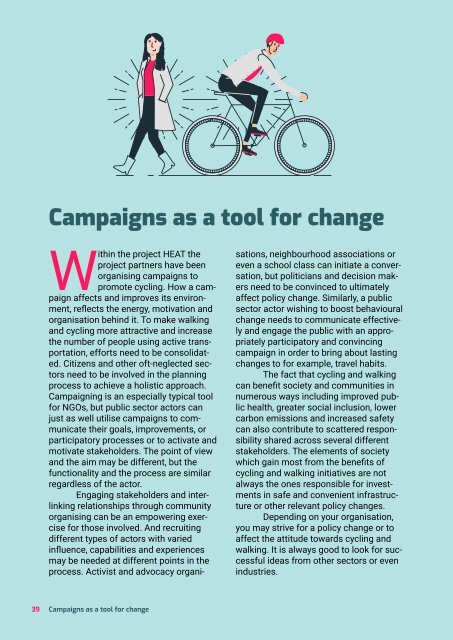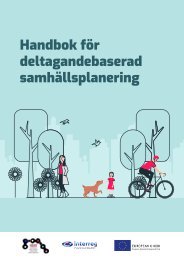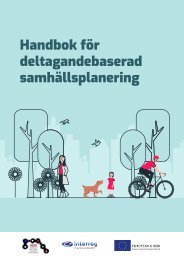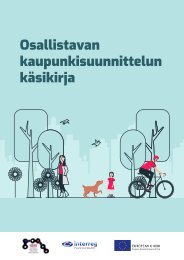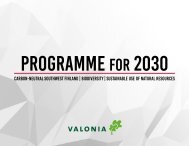Handbook for Participatory Urban Planning
This handbook is a result of an EU-funded project “HEAT - participatory urban planning for healthier urban communities”. For the last two years, the project partners from Finland, Estonia, Latvia and Sweden have worked with more inclusive and participatory processes with a focus on sustainable and healthy communities, particularly related to cycling. Nevertheless, the same principle charts the course, more or less, in any participatory process: you have a goal, and you are trying to find the best available paths to reach it. As the topic is not simple and the change is not happening overnight, we wanted to share our experiences and the knowledge gained during the project with the hope to help or inspire others trying to tackle similar issues.
This handbook is a result of an EU-funded project “HEAT - participatory urban planning for healthier urban communities”. For the last two years, the project partners from Finland, Estonia, Latvia and Sweden have worked with more inclusive and participatory processes with a focus on sustainable and healthy communities, particularly related to cycling. Nevertheless, the same principle charts the course, more or less, in any participatory process: you have a goal, and you are trying to find the best available paths to reach it. As the topic is not simple and the change is not happening overnight, we wanted to share our experiences and the knowledge gained during the project with the hope to help or inspire others trying to tackle similar issues.
You also want an ePaper? Increase the reach of your titles
YUMPU automatically turns print PDFs into web optimized ePapers that Google loves.
How to plan a successful<br />
campaign<br />
Campaigns as a tool <strong>for</strong> change<br />
Within the project HEAT the<br />
project partners have been<br />
organising campaigns to<br />
promote cycling. How a campaign<br />
affects and improves its environment,<br />
reflects the energy, motivation and<br />
organisation behind it. To make walking<br />
and cycling more attractive and increase<br />
the number of people using active transportation,<br />
ef<strong>for</strong>ts need to be consolidated.<br />
Citizens and other oft-neglected sectors<br />
need to be involved in the planning<br />
process to achieve a holistic approach.<br />
Campaigning is an especially typical tool<br />
<strong>for</strong> NGOs, but public sector actors can<br />
just as well utilise campaigns to communicate<br />
their goals, improvements, or<br />
participatory processes or to activate and<br />
motivate stakeholders. The point of view<br />
and the aim may be different, but the<br />
functionality and the process are similar<br />
regardless of the actor.<br />
Engaging stakeholders and interlinking<br />
relationships through community<br />
organising can be an empowering exercise<br />
<strong>for</strong> those involved. And recruiting<br />
different types of actors with varied<br />
influence, capabilities and experiences<br />
may be needed at different points in the<br />
process. Activist and advocacy organisations,<br />
neighbourhood associations or<br />
even a school class can initiate a conversation,<br />
but politicians and decision makers<br />
need to be convinced to ultimately<br />
affect policy change. Similarly, a public<br />
sector actor wishing to boost behavioural<br />
change needs to communicate effectively<br />
and engage the public with an appropriately<br />
participatory and convincing<br />
campaign in order to bring about lasting<br />
changes to <strong>for</strong> example, travel habits.<br />
The fact that cycling and walking<br />
can benefit society and communities in<br />
numerous ways including improved public<br />
health, greater social inclusion, lower<br />
carbon emissions and increased safety<br />
can also contribute to scattered responsibility<br />
shared across several different<br />
stakeholders. The elements of society<br />
which gain most from the benefits of<br />
cycling and walking initiatives are not<br />
always the ones responsible <strong>for</strong> investments<br />
in safe and convenient infrastructure<br />
or other relevant policy changes.<br />
Depending on your organisation,<br />
you may strive <strong>for</strong> a policy change or to<br />
affect the attitude towards cycling and<br />
walking. It is always good to look <strong>for</strong> successful<br />
ideas from other sectors or even<br />
industries.<br />
A<br />
successful campaign always<br />
starts with identifying a problem<br />
and a need <strong>for</strong> action. The<br />
motive to act can be triggered<br />
by public opinion or the media, or it can<br />
be an existential threat to health such as<br />
poor air quality or an epidemic of sedentary<br />
lifestyles. Take the time to clearly<br />
identify and <strong>for</strong>mulate the problem your<br />
campaign is addressing. Ask “why?” a lot.<br />
Why is this situation this way? What is<br />
the cause? Dig into the issue and consult<br />
with the people it affects, experts and<br />
researchers. No matter how small or big<br />
your campaign resources are, you should<br />
spend time on defining your perspective<br />
on the subject matter and the importance<br />
of it to others.<br />
Once a problem is identified, determine<br />
your solution. Is it raising awareness<br />
or a policy solution? What can be<br />
done and what is the goal you want to<br />
achieve? How will you get there and what<br />
specific actions need to be taken, when<br />
and by whom? As an example, consider<br />
the solution of a new bike lane. To push<br />
<strong>for</strong> this solution you must also determine<br />
how much it will cost, where the funds<br />
will come from, what the approval and<br />
development process looks like, as well<br />
as the potential impacts on other factors<br />
such as traffic congestion, public health<br />
and the wider economic, social and environmental<br />
effects.<br />
After you have identified the solution<br />
to your problem, the change that your<br />
campaign will seek to achieve, you need<br />
to identify relevant stakeholders and target<br />
groups <strong>for</strong> your campaign. You need<br />
to be sure to know who your campaign is<br />
addressing. Who has the power to secure<br />
the outcome you want <strong>for</strong> your campaign<br />
- is it a politician who has to make<br />
a certain decision or is it a sector of the<br />
public you want to participate in a certain<br />
action or activity? Be sure also to identify<br />
why it is important <strong>for</strong> them and why they<br />
should care about the issue. You need<br />
to identify these issues in order to effectively<br />
communicate to the target group<br />
through your campaign. This is where<br />
a stakeholder mapping exercise (see<br />
39<br />
Campaigns as a tool <strong>for</strong> change How to plan a successful campaign 40


